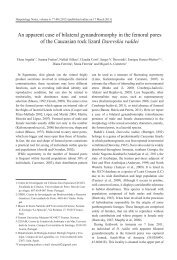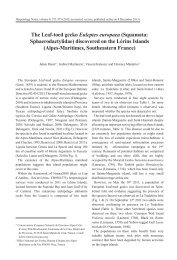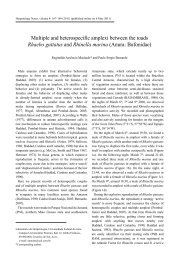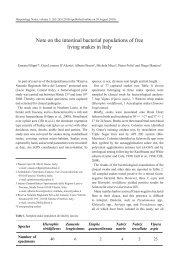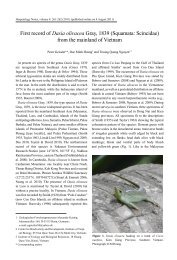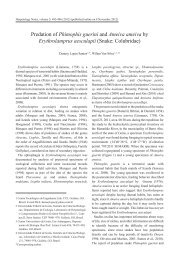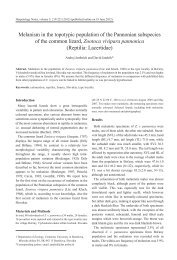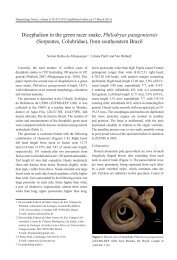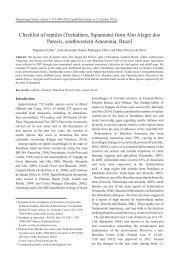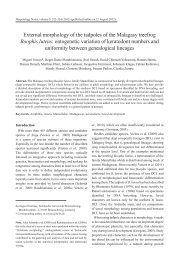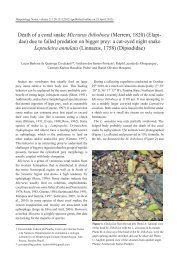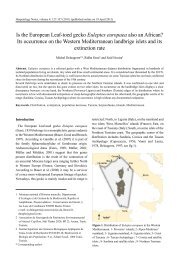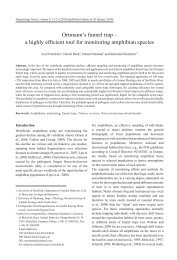Notes on some dietary items of Eutropis longicaudata - Herpetology ...
Notes on some dietary items of Eutropis longicaudata - Herpetology ...
Notes on some dietary items of Eutropis longicaudata - Herpetology ...
Create successful ePaper yourself
Turn your PDF publications into a flip-book with our unique Google optimized e-Paper software.
<strong>Herpetology</strong> <str<strong>on</strong>g>Notes</str<strong>on</strong>g>, volume 5: 453-456 (2012) (published <strong>on</strong>line <strong>on</strong> 7 October 2012)<br />
<str<strong>on</strong>g>Notes</str<strong>on</strong>g> <strong>on</strong> <strong>some</strong> <strong>dietary</strong> <strong>items</strong> <strong>of</strong> <strong>Eutropis</strong> l<strong>on</strong>gicaudata (Hallowell,<br />
1857), Japalura polyg<strong>on</strong>ata xanthostoma Ota, 1991,<br />
Plestiod<strong>on</strong> elegans (Boulenger, 1887), and Sphenomorphus indicus<br />
(Gray, 1853) from Taiwan<br />
Gerrut Norval 1,* , Shao-Chang Huang 2 , Jean-Jay Mao 3 , and Stephen R. Goldberg 4<br />
An understanding <strong>of</strong> the natural history and ecology <strong>of</strong><br />
reptile and amphibian species is essential for successful<br />
c<strong>on</strong>servati<strong>on</strong> and management programs (Bury, 2006). A<br />
crucial part <strong>of</strong> the natural history <strong>of</strong> an animal is its diet,<br />
because not <strong>on</strong>ly does it reveal the source <strong>of</strong> the animal’s<br />
energy for growth, maintenance, and/or reproducti<strong>on</strong><br />
(Dunham, Grant and Overall, 1989; Zug et al., 2001), it<br />
also indicates part <strong>of</strong> the ecological roles <strong>of</strong> the animal.<br />
Since there may be temporal and spatial variati<strong>on</strong>s<br />
in the diet <strong>of</strong> a species (e.g. Lahti and Beck, 2008;<br />
Rodríguez et al., 2008; Goodyear and Pianka, 2011),<br />
there is a need for <strong>dietary</strong> descripti<strong>on</strong>s from different<br />
localities. For this reas<strong>on</strong>, observati<strong>on</strong>s made <strong>on</strong> an ad<br />
hoc basis and descripti<strong>on</strong>s from small collecti<strong>on</strong>s can be<br />
instrumental in developing a better understanding <strong>of</strong> the<br />
diet <strong>of</strong> a species. Herein, we describe the <strong>dietary</strong> <strong>items</strong><br />
<strong>of</strong> six lizards that died when they were accidentally<br />
collected in 2003 by pitfall traps that were set as part<br />
<strong>of</strong> an ecological study in Yangmingshan Nati<strong>on</strong>al Park,<br />
northern Taiwan. We also incorporate and describe the<br />
<strong>dietary</strong> <strong>items</strong> <strong>of</strong> three DOR (dead <strong>on</strong> road) specimens<br />
<strong>of</strong> the scincid, <strong>Eutropis</strong> l<strong>on</strong>gicaudata, collected <strong>on</strong> an<br />
ad hoc basis, from tarred roads in an agricultural area<br />
<strong>of</strong> Santzepu, Sheishan District, Chiayi County, southwestern<br />
Taiwan.<br />
The lizards were treated as follows; the snout-vent<br />
1 Applied Behavioural Ecology & Ecosystem Research Unit,<br />
Department <strong>of</strong> Envir<strong>on</strong>mental Sciences, UNISA, Private Bag<br />
X6, Florida, 1710, Republic <strong>of</strong> South Africa.<br />
2 Queensland Brain Institute, QBI Building (79), Upland<br />
Road, The University <strong>of</strong> Queensland, St Lucia, QLD 4072,<br />
Australia.<br />
3 Department <strong>of</strong> Forestry & Natural Resources, Nati<strong>on</strong>al Ilan<br />
University. No. 1, Sec. 1, Shen-Lung Rd., Ilan, 260, Taiwan,<br />
R.O.C.<br />
4 Department <strong>of</strong> Biology, Whittier College, Whittier, California<br />
90608, USA.<br />
*Corresp<strong>on</strong>ding author; e-mail: gnorval@gmail.com<br />
length (SVL) and tail length (TL) were measured to the<br />
nearest mm with a transparent plastic ruler; and the tail<br />
was scored as complete or broken. The E. l<strong>on</strong>gicaudata<br />
were weighed (body mass) to the nearest 0.1g with a<br />
digital scale, but since the specimens from northern<br />
Taiwan were partially dissected and not intact, their<br />
body masses were not recorded. All the lizards were<br />
dissected by making a mid-ventral incisi<strong>on</strong>, and the<br />
stomach was removed and slit l<strong>on</strong>gitudinally, after<br />
which the stomach c<strong>on</strong>tent was removed. The stomach<br />
c<strong>on</strong>tents were spread in a petri dish and examined under<br />
a dissecti<strong>on</strong> microscope, and all the prey <strong>items</strong> were<br />
identified to the order level and, if possible, to family<br />
or species level.<br />
Three Japalura polyg<strong>on</strong>ata xanthostoma (Agamidae),<br />
were examined. Two were females, and both had a SVL<br />
<strong>of</strong> 58 mm, but <strong>on</strong>e had a TL <strong>of</strong> 115 mm, while that <strong>of</strong><br />
the other was 104 mm. The sex <strong>of</strong> the third specimen<br />
was not determined. It had a SVL <strong>of</strong> 39 mm and a TL <strong>of</strong><br />
70 mm. On the 29th <strong>of</strong> March, 2002, we collected an E.<br />
l<strong>on</strong>gicaudata male, with a SVL <strong>of</strong> 109 mm, TL <strong>of</strong> 174<br />
mm, and body mass <strong>of</strong> 30.2 g (the exact locality was not<br />
recorded), and <strong>on</strong> the 18th <strong>of</strong> March, 2003, we collected<br />
another male (at 23º25’47”N, 120º28’52”E; datum:<br />
Figure 1. The yellow-mouthed tree lizard (Japalura<br />
polyg<strong>on</strong>ata xanthostoma) is an endemic sub-species, restricted<br />
to northeastern, northern and northwestern Taiwan, in areas<br />
below 1000 m (photographed by Jean-Jay Mao).
454<br />
Figure 2. The l<strong>on</strong>g-tailed skink (<strong>Eutropis</strong> l<strong>on</strong>gicaudata)<br />
is the largest native lizard species in Taiwan, and is <strong>of</strong>ten a<br />
comm<strong>on</strong> species in areas disturbed by anthropogenic activities<br />
(photographed by Gerrut Norval).<br />
WGS84), with a SVL <strong>of</strong> 122 mm, TL <strong>of</strong> 179 mm, and a<br />
body mass <strong>of</strong> 49.1 g. On the 29th <strong>of</strong> September, 2002,<br />
a female was collected (at 23º25’47”N, 120º28’56”E;<br />
datum: WGS84). The lizard had a SVL <strong>of</strong> 105 mm, and<br />
body mass <strong>of</strong> 27.4 g (including the fragments <strong>of</strong> the tail<br />
that could be collected), but since the tail was mutilated<br />
no TL was recorded. One Plestiod<strong>on</strong> elegans (Scincidae)<br />
specimen was examined. It had a SVL <strong>of</strong> 40 mm and a<br />
TL <strong>of</strong> 73 mm. The sex was also not determined. Two<br />
Sphenomorphus indicus (Scincidae) specimens were<br />
examined. Both were males, and had a SVL <strong>of</strong> 68 mm,<br />
but <strong>on</strong>e had a TL <strong>of</strong> 105 mm, while that <strong>of</strong> the other was<br />
84 mm, <strong>of</strong> which 24 mm was a regenerated tail.<br />
Fifty-nine prey <strong>items</strong>, which bel<strong>on</strong>ged to 14 orders<br />
from 7 classes, were recorded in this study (Table 1).<br />
The most numerous prey <strong>items</strong> were ants, followed by<br />
spiders, earthworms, lepidopteran larvae, woodlice, and<br />
flies, in that order.<br />
Figure 3. The elegant skink (Plestiod<strong>on</strong> elegans) is a<br />
comm<strong>on</strong> species island wide in open mountainous areas and<br />
areas disturbed by anthropogenic activities below 2500 m<br />
(photographed by Gerrut Norval).<br />
Gerrut Norval et al.<br />
Figure 4. The Indian forest skink (Sphenomorphus indicus) is<br />
a comm<strong>on</strong> species island wide in forested areas below 1500 m<br />
(photographed by Gerrut Norval).<br />
Most <strong>of</strong> the prey <strong>items</strong> <strong>of</strong> J. p. xanthostoma reported<br />
herein bel<strong>on</strong>g to orders that were also reported by<br />
Kuo, Lin and Lin (2007) as prey <strong>of</strong> this species. The<br />
<strong>on</strong>ly excepti<strong>on</strong>s were flies (Diptera), mite (Acarina),<br />
and earthworms (Haplotaxida). Rather than being due<br />
to a difference in diet, this may simply be because<br />
earthworms tend to digest fairly quickly, and may be<br />
overlooked if lizards are not fixed shortly after being<br />
collected. It must also be remembered that earthworms<br />
are rarely active <strong>on</strong> the soil surface during the day,<br />
and would thus be a prey item that these lizards rarely<br />
encounter. The majority <strong>of</strong> the prey <strong>items</strong> we recorded<br />
from E. l<strong>on</strong>gicaudata bel<strong>on</strong>ged to orders that were also<br />
reported by Huang (2006) as prey <strong>of</strong> c<strong>on</strong>specifics from<br />
Orchid Island. However, unlike in this study, Huang<br />
(2006) did not record earthworms (Order: Haplotaxida)<br />
as prey <strong>of</strong> E. l<strong>on</strong>gicaudata. Again, rather than indicating<br />
<strong>dietary</strong> variati<strong>on</strong>, this is more likely due to reas<strong>on</strong>s<br />
as explained earlier for J. p. xanthostoma. Huang<br />
(2006) recorded Gekko hokounensis Zhou, 1982, and<br />
Hemidactylus frenatus Schlegel, 1836, as well as the<br />
eggs <strong>of</strong> <strong>Eutropis</strong> multicarinata (Gray, 1845) (reported as<br />
Mabuya multicarinata) and Sphenomorphus incognitus<br />
Thomps<strong>on</strong>, 1912, as <strong>dietary</strong> <strong>items</strong> <strong>of</strong> E. l<strong>on</strong>gicaudata<br />
from Orchid Island, and Norval, Mao and Chu (2004)<br />
described an instance <strong>of</strong> E. l<strong>on</strong>gicaudata (reported as<br />
Mabuya l<strong>on</strong>gicaudata) predati<strong>on</strong> <strong>on</strong> Anolis sagrei<br />
Duméril & Bibr<strong>on</strong>, 1837, an exotic invasive species in<br />
Taiwan, so ovophagy and saurophagy are known for this<br />
species. Still, the remains <strong>of</strong> a lizard egg, and toe and tail<br />
fragments, as well as scales, <strong>of</strong> the embryo were found in<br />
the stomach <strong>of</strong> the first E. l<strong>on</strong>gicaudata described herein.<br />
Based <strong>on</strong> these fragments it was possible to determine<br />
that the egg was that <strong>of</strong> a Takydromus species. Since<br />
T. formosanus (Boulenger, 1894) is the <strong>on</strong>ly species <strong>of</strong><br />
this genus in the area where the E. l<strong>on</strong>gicaudata was<br />
collected, we are c<strong>on</strong>fident that the egg was that <strong>of</strong> T.<br />
formosanus. Our observati<strong>on</strong> is thus the first reported
<str<strong>on</strong>g>Notes</str<strong>on</strong>g> <strong>on</strong> <strong>some</strong> <strong>dietary</strong> <strong>items</strong> <strong>of</strong> lizards in Taiwan 455<br />
Table 1. The <strong>dietary</strong> <strong>items</strong> <strong>of</strong> the Japalura polyg<strong>on</strong>ata xanthostoma (J.p.x.), <strong>Eutropis</strong> l<strong>on</strong>gicaudata (E.l.), Plestiod<strong>on</strong> elegans<br />
(P.e.), and Sphenomorphus indicus (S.i.) described herein. The number <strong>of</strong> lizards, <strong>of</strong> each species, that preyed up<strong>on</strong> each prey<br />
type is indicated in parenthesis. The prey <strong>items</strong> bel<strong>on</strong>ged to the following orders, Coleoptera (Cole.), Diptera (Dipt.), Hemiptera<br />
(Hemi.), Hymenoptera (Hyme.), Lepidoptera (Lepi.), Mantodea (Mant.), Orthoptera (Orth.), Scolopendromorpha (Scol.),<br />
Spirobolida (Spir.), Acarina (Acar.), Aranea (Aran.), Isopoda (Isop.), Squamata (Squa.), and Haplotaxida (Hapl.). (* indicates that<br />
it is an egg.)<br />
instance <strong>of</strong> predati<strong>on</strong> <strong>on</strong> the eggs <strong>of</strong> T. formosanus by<br />
E. l<strong>on</strong>gicaudata. As for P. elegans, the observati<strong>on</strong>s<br />
described herein are the first descripti<strong>on</strong> <strong>of</strong> <strong>dietary</strong> <strong>items</strong><br />
<strong>of</strong> this lizard in Taiwan. All the prey <strong>items</strong> from the S.<br />
indicus described herein bel<strong>on</strong>g to <strong>some</strong> <strong>of</strong> the orders<br />
described by Shieh, Juan and Lue (1986) as prey <strong>of</strong> this<br />
species from northern Taiwan.<br />
Based <strong>on</strong> what is known about the food intake <strong>of</strong> the<br />
four lizard species described herein, it is clear that these<br />
species are <strong>dietary</strong> generalists. However, there are <strong>some</strong><br />
differences in their foraging modes. The type <strong>of</strong> prey<br />
J.p.x. E.l. P.e. S.i.<br />
Class Order Family F % F % F % F %<br />
Insecta Cole. Unknown 1 (1) 3.45 1 (1) 7.14 - -<br />
Scarabaeidae - 1 (1) 7.14 - -<br />
Dipt. Unknown 4 (2) 13.8 - - -<br />
Hemi. Unknown - 2 (1) 14.3 - -<br />
Pentatomidae - 1 (1) 7.14 - -<br />
Hyme. Formicidae 12 (2) 41.4 4 (2) 28.6 - 1 (1) 12.5<br />
Lepi. Noctuidae 3 (3) 10.3 2 (1) 14.3 - 1 (1) 12.5<br />
Mant. Unknown - 1 (1) 7.14 -<br />
Orth. Gryllidae - - 1 (1) 12.5 2 (2) 25<br />
Chilopoda Scol. Unknown 1 (1) 3.45 - - -<br />
Diplopoda Spir. Unknown 1 (1) 3.45 - - -<br />
Arachnida Acar. Acariformes 1 (1) 3.45 - - -<br />
Aran. Unknown 1 (1) 3.45 - 6 (1) 75 -<br />
Crustacea Isop. Pocelli<strong>on</strong>idae 1 (1) 3.45 - 1 (1) 12.5 3 (2) 37.5<br />
Reptilia Squa. Lacertidae* - 1 (1) 7.14 -<br />
Clitellata Hapl. Unknown 4 (3) 13.8 1 (1) 7.14 - 1 (1) 12.5<br />
TOTAL 29 14 8 8<br />
c<strong>on</strong>sumed by lizards is <strong>of</strong>ten determined by the foraging<br />
mode <strong>of</strong> the lizard. Lizard foraging modes can typically<br />
be classified as a very active, cruising predator (“widely<br />
foraging”), which tend to prey more <strong>on</strong> prey types that<br />
are sedentary, unpredictably distributed, clumped, and/or<br />
are large and hidden; or as a sedentary, ambush predator<br />
(“sit-and-wait”), which tend to prey <strong>on</strong> more active prey,<br />
that is mobile, <strong>on</strong> the surface, and visually c<strong>on</strong>spicuous<br />
(Huey and Pianka 1981; Pianka and Vitt 2003). The<br />
occurrence <strong>of</strong> primarily mobile and c<strong>on</strong>spicuous<br />
prey (e.g. ants, flies, and lepidopteran larvae) in the
456<br />
diet <strong>of</strong> J. p. xanthostoma suggests that this species is<br />
an opportunistic ambush foraging species. Because<br />
millipedes (Diplopoda) are known to produce toxins,<br />
and active foraging lizards can presumably detect the<br />
toxic compounds released by these prey and therefore<br />
avoid them (Vitt and Cooper, 1986), the occurrence <strong>of</strong><br />
prey such as millipedes in the diet <strong>of</strong> J. p. xanthostoma<br />
is additi<strong>on</strong>al pro<strong>of</strong> <strong>of</strong> the ambush foraging strategy <strong>of</strong><br />
this species. As for the skinks (Scincidae), the presence<br />
<strong>of</strong> prey that is usually nocturnal (e.g. crickets), cryptic<br />
(e.g. preying mantis), inactive (e.g. fruits and seeds),<br />
and/or hidden (e.g. lizard eggs and woodlice), suggests<br />
that all three species are active foragers.<br />
Acknowledgements. The management <strong>of</strong> Yangmingshan Nati<strong>on</strong>al<br />
Park issued a collecti<strong>on</strong> permit (No. 0920000848) to Pr<strong>of</strong>. I-Min<br />
Tso, and we are grateful to him for d<strong>on</strong>ating the lizards to us for<br />
study. The authors would also like to express their gratitude to<br />
Gernot Vogel and Meng Hsien Chuang for their comments and<br />
for reviewing this paper.<br />
References<br />
Bury, B.R. (2006): Natural history, field ecology, c<strong>on</strong>servati<strong>on</strong><br />
biology and wildlife management: time to c<strong>on</strong>nect the dots.<br />
Herpetological C<strong>on</strong>servati<strong>on</strong> and Biology 1: 56-61.<br />
Dunham, A.E., Grant, B.W., Overall, K.L. (1989): Interfaces<br />
between biophysical and physiological ecology and populati<strong>on</strong><br />
ecology <strong>of</strong> terrestrial vertebrate ectotherms. Physiological<br />
Zoology 62: 335-355.<br />
Goodyear, S.E., Pianka, E.R. (2011): Spatial and temporal variati<strong>on</strong><br />
in diets <strong>of</strong> sympatric lizards (Genus Ctenotus) in the Great<br />
Victoria Desert, Western Australia. Journal <strong>of</strong> <strong>Herpetology</strong> 45:<br />
265-271.<br />
Gerrut Norval et al.<br />
Huang, W.S. (2006): Ecological characteristics <strong>of</strong> the skink, Mabuya<br />
l<strong>on</strong>gicaudata, <strong>on</strong> a tropical East Asian Island. Copeia<br />
2006: 293-300.<br />
Huey R.B., Pianka E.R. (1981): Ecological c<strong>on</strong>sequences <strong>of</strong> foraging<br />
mode. Ecology 62: 991-999.<br />
Kuo, C.Y., Lin, Y.S., Lin, Y.K. (2007): Resource use and morphology<br />
<strong>of</strong> two sympatric Japalura lizards (Iguania: Agamidae).<br />
Journal <strong>of</strong> <strong>Herpetology</strong> 41: 713-723.<br />
Lahti, M.E., Beck, D.D. (2008): Ecology and <strong>on</strong>togenetic variati<strong>on</strong><br />
<strong>of</strong> diet in the pigmy short-horned lizard (Phrynosoma douglasii).<br />
American Midland Naturalist 159: 327-339.<br />
Norval, G., Mao, J.J., Chu, H.P. (2004): Mabuya l<strong>on</strong>gicaudata<br />
(L<strong>on</strong>g-tailed Skink). Predati<strong>on</strong>. Herpetological Review 35:<br />
393-394.<br />
Pianka E.R., Vitt L.J. (2003): Lizards: Windows to the Evoluti<strong>on</strong><br />
<strong>of</strong> Diversity. Berkeley, University <strong>of</strong> California Press.<br />
Rodríguez, A., Nogales, M., Rumeu, B., Rodríguez, B. (2008):<br />
Temporal and spatial variati<strong>on</strong> in the diet <strong>of</strong> the endemic lizard<br />
Gallotia galloti in an insular Mediterranean scrubland. Journal<br />
<strong>of</strong> <strong>Herpetology</strong> 42: 213-222.<br />
Shang, G.S., Lin, S.L. (2001): Natural Portraits <strong>of</strong> the Lizards <strong>of</strong><br />
Taiwan. Taipei, Big Trees Publishers. (In Chinese)<br />
Shieh, C.J., Juan, L.Y., Lue, K.Y. (1986): The study <strong>of</strong> the feeding<br />
habit <strong>of</strong> Sphenomorphus indicus in Ha-Pen area, Taipei County.<br />
Biological Bulletin <strong>of</strong> Nati<strong>on</strong>al Taiwan Normal University<br />
21: 73-84. (In Chinese)<br />
Vitt L.J., Cooper W.E. (1986): Foraging and diet <strong>of</strong> a diurnal predator<br />
(Eumeces laticeps) feeding <strong>on</strong> hidden prey. Journal <strong>of</strong><br />
<strong>Herpetology</strong> 20: 208-415.<br />
Zug, G.R., Vitt, L.J., Caldwell, J.P. (2001): <strong>Herpetology</strong>. An Introductory<br />
Biology <strong>of</strong> Amphibians and Reptiles. 2nd editi<strong>on</strong>.<br />
San Diego, Academic Press.<br />
Accepted by Wouter Beukema



